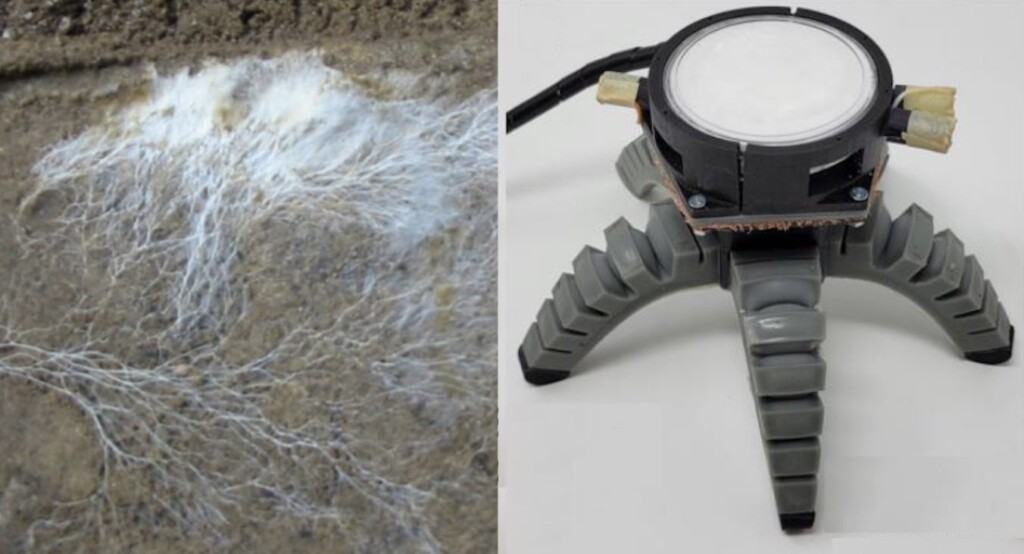 Mycelium photo by Lex VB (CC 3.0. license) with robot by Cornell University
Mycelium photo by Lex VB (CC 3.0. license) with robot by Cornell UniversityThere’s no question that when most people think of robotics, they imagine a field of metal, mechanisms, and wires.
Yet today, in the growing field of biohybrid robotics, one can watch as a traditional robot is animated to mechanical life at the command of a mushroom.
A mushroom’s fungal filaments, known as mycelia, are known to carry electrical impulses in a way not too dissimilar from how human neurons control our muscle tissues. Knowing this, scientists at Cornell University wanted to see if mycelia, which are sort of like a mushroom’s root system, could, if mapped onto a circuit board, drive a robotic starfish’s locomotion.
Turns out, it can—quite easily, in fact (see the video below). It’s just a shame that there’s no cockpit where the mushroom can be positioned.
“The mycelia sense their environment and issue… control signals to the motors and valves of the robots that we designed and built,” the authors of the study write in their abstract.
“We used these signals to control a walking soft robot as well as a wheeled hard one. We also demonstrated the use of mycelia to respond to environmental cues by using ultraviolet light stimulation to augment the robots’ gaits.”
The researchers were looking to create biohybrid robotic systems without using plant or animal cells. Cells are, in general, a great tool in robotics because of all the ways they respond to stimuli. But there are ethical entanglements from using mouse muscle tissues or neurons to build robots, and plant cells are often, like the plants themselves, very slow to respond to commands.
Furthermore, plant and animal cells are delicate and will die quite easily if any hostile environmental factors are introduced, leaving the robot a derelict piece of e-waste.
“The conditions to keep the mycelium alive seem to be easier to achieve in a robot than the systems we need to keep mouse muscle alive, for example,” Vickie Webster-Wood, an engineer at Carnegie Mellon University not involved in the mushroom robotics study, told Nat Geo.
BIOLOGICAL SURPRISES: Student Treks to Yellowstone and Finds Bacteria That Eats Pollution and ‘Breathes’ Electricity
“So there’s some potential there to do longer-mission environmental work.”
Biohybrid robotics has similar concepts to so-called soft robotics, which is a sub-field that seeks to produce constructs that move but don’t need mechanical components, or sometimes even electrical ones.
ALSO LOOK AT THIS: Porcini Mushrooms Rank Among Highest in the World for Rare ‘Essential Vitamin’
These include flabby gel bots that expand and contract based on changes in the surrounding magnetic field, which could be used inside human bodies to deliver targeted medication at wound sites or tumors.
Using king oyster mushrooms, the researchers cultivated fungal mycelium onto a 3D-printed scaffold full of electrodes. The electrical impulses given off by the mycelium could be picked up by the electrodes which could then be translated into computer commands to control the robot.
MORE MUSHROOM-BASED STORIES: Mushrooms Help Turn Toxic Brownfields into Blooming Meadows
Because fungal cells can survive in radioactive environments, salt water, and extreme cold, it gives a mycelia-connected robot a much greater range of uses. They could be used in agriculture to gather soil and crop data or sent into radioactive sites to clean up contamination.
WATCH the robot move via mushroom commands below…
SET MUSHROOM FANS A-HOPPIN’ By Sharing This on Social Media!
Source link

